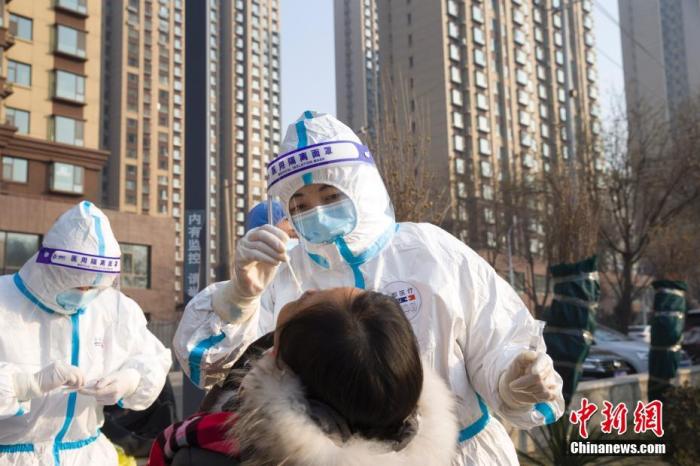China News Service, January 27. According to Zeng Yixin, deputy director of the National Health Commission, on the 27th, as of now, the nation’s new coronavirus nucleic acid detection capacity has exceeded 15 million copies per day. This refers to single tube, one per person; if implemented If five people have one tube, or ten people have one tube, the nucleic acid detection capabilities should be further improved, which will provide a strong guarantee for prevention and control.
Data map: On January 21, a nucleic acid test was conducted in Jinzhong, Shanxi Province.
Photo by China News Agency reporter Zhang Yun
The State Council’s Joint Prevention and Control Mechanism held a press conference on the 27th. At the meeting, Zeng Yixin pointed out that since December last year, clusters of new crown pneumonia epidemics have occurred in some places in my country, and in some places there have been multiple cases in the same province or city. There are clusters of cases in families and communities.
In general, there have been some new changes in the current epidemic prevention and control work, which are mainly manifested in three aspects:
The first change is that most of the epidemics occurred in northern regions with cold weather, because of the cold weather, low temperature, and long survival time of the virus.
In addition, these epidemics are relatively concentrated in rural areas, and the prevention and control work in rural areas is relatively weak, so it is easy to cause the epidemic to spread more widely.
The second change is that the number of imported cases abroad has increased significantly.
In January this year, the average number of imported cases per day was nearly twice that of November last year, so the pressure on foreign defense imports continued.
The third change is that the Spring Festival is approaching, the flow of people and logistics will increase, gatherings, gatherings and other gathering activities will also increase, which will increase the risk of epidemic spread. Therefore, it is expected that after the Spring Festival this year, the overseas epidemic will pass before the temperature rises significantly. The risk of local transmission caused by imported items is still high, and the epidemic prevention and control situation is still complicated and severe.
Zeng Yixin said that in order to effectively cope with the new challenges in the current epidemic prevention and control work, and at the same time cooperate with relevant departments to do a good job in epidemic prevention and control during the Spring Festival travel period and the people's on-site guarantee for the New Year, the implementation of the work will be promoted in the following aspects.
One is to continue to make up for the shortcomings and weaknesses of the rural epidemic prevention and control work.
The recent epidemics are more concentrated in rural areas. On the basis of urging all localities to strictly implement the measures in the "Work Plan for the Prevention and Control of New Coronary Pneumonia Epidemics in Rural Areas in Winter and Spring" regarding testing, circulation, isolation, transportation, treatment, and information release. Further clarify the travel requirements of people in areas with different risk levels.
In response to the increase in the demand for nucleic acid testing of returnees during the Spring Festival travel season, we will guide all localities to improve nucleic acid testing capabilities, actively explore to reduce the cost of nucleic acid testing, improve the timeliness of nucleic acid testing, and increase the convenience of nucleic acid testing.
Up to now, the national new coronavirus nucleic acid detection capacity has exceeded 15 million copies/day. This refers to a single tube, one for each person. If five people one tube or 10 people one tube mixed inspection is implemented, the nucleic acid detection capacity should be Further improvement will provide a strong guarantee for prevention and control work.
The second is to further standardize the handling of clustered epidemics.
"We have comprehensively sorted out some of the situations and handling experience exposed in the epidemic response work in Xinjiang Kashgar, Hebei Shijiazhuang, Heilongjiang Suihua, etc., and refined, actualized and hardened the entire process of handling clusters of epidemics. Local governments at all levels must promptly activate the emergency command system and quickly organize specialized epidemiological investigations and traceability work." Zeng Yixin introduced.
Zeng Yixin said that once an epidemic occurs, it is necessary to find the source as soon as possible and understand how the epidemic occurred, so that we can better take targeted measures to control the epidemic.
It is necessary to timely, scientifically and accurately delineate and adjust the medium and high-risk areas, and implement measures such as community and individual isolation control and nucleic acid testing in different areas.
The third is to continue to do a good job of external defense input.
First, it is necessary to further strengthen the standardized management of the entire chain of immigrants from the airport to the isolation site, and then to the community, requiring all regions to prepare enough isolation rooms, comprehensively strengthen the management of isolation sites, standardize service guarantees, and avoid cross-infection.
Secondly, it is required to strictly implement the responsibilities of industries and units such as imported cold chain food and imported goods, and relevant key practitioners must strictly perform personal protection, and give priority to key personnel to vaccinate the new crown vaccine. This work is ongoing.
The fourth is to continue to strengthen health science.
Zeng Yixin said that recently, various forms of health science activities have been carried out around winter and spring epidemic prevention and control, personal protection, etc., to widely popularize scientific protection knowledge, and encourage the masses to develop good habits of wearing masks, washing hands frequently, and maintaining social distance. Personal hygiene, pay attention to environmental hygiene, maintain good ventilation, enhance personal protection awareness, and improve self-protection capabilities.

